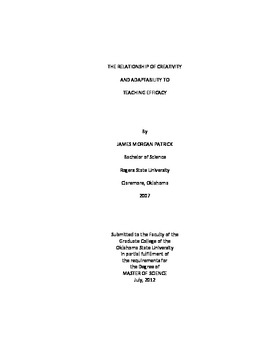| dc.contributor.advisor | Montgomery, Diane M. | |
| dc.contributor.author | Patrick, James Morgan | |
| dc.date.accessioned | 2014-04-16T03:06:55Z | |
| dc.date.available | 2014-04-16T03:06:55Z | |
| dc.date.issued | 2012-12-01 | |
| dc.identifier.uri | https://hdl.handle.net/11244/9615 | |
| dc.description.abstract | The purpose of this study was to determine the relationship of creativity and adaptability to the teaching efficacy for elementary and secondary teachers. Participants in this study consisted of 34 elementary and secondary teachers from four participating school systems. A paper survey consisting of The Runco Ideational Behavior Scale (Runco, Lim, Plucker, 2000) was used to determine the self perceptions of generating creative ideas (creativity). The Soh Change Scale (Soh, 1985) was used to determine perceptions of change as normal and/or enriching (adaptability). The Teacher Sense of Efficacy Scale (TSES; Tschannen-Moran & Woolfolk-Hoy, 2001) measured the variable of self efficacy in the three areas of instructional strategies, classroom management, and student engagement. Following the collection of the surveys the data were entered into the SPSS version 19 computer program to determine reliabilities of the instrument followed by a calculation of correlations to check for possible relationships between the scale totals and subscales. Results of the scale and subscale reliabilities were favorable for the measures of creativity, adaptability and teaching self efficacy. Of particular not is the similarity of these reliabilities to the results of previously reported scores suggesting that the measures were reliable. A correlation of all subscales and total scores was conducted to determine relationships between all variables. Findings indicate change as Normal has a negative relationship to seeing change as Enriching; to Creativity Total, and its subscales of Ideation and Behavior; and to only the subscale of Student Engagement of Teaching Efficacy. Teaching Efficacy and all subscales are significantly related to Creativity Total score and the Ideation subscale; however, Classroom Management and Instructional Strategies are not related to Creativity Behavior. Creativity subscales are related to the Total Ideation score in a positive way. Teaching Efficacy subscales are related to the Totals Teaching Efficacy score in a positive way. Change subscales are related to the Total Soh Scale with Enrichment in a negative way and Normal in a positive way. These findings provide implications for future research. | |
| dc.format | application/pdf | |
| dc.language | en_US | |
| dc.publisher | Oklahoma State University | |
| dc.rights | Copyright is held by the author who has granted the Oklahoma State University Library the non-exclusive right to share this material in its institutional repository. Contact Digital Library Services at lib-dls@okstate.edu or 405-744-9161 for the permission policy on the use, reproduction or distribution of this material. | |
| dc.title | Relationship of Creativity and Adaptability to Teaching Efficacy | |
| dc.type | text | |
| dc.contributor.committeeMember | Harrist, Steve | |
| dc.contributor.committeeMember | Cho, Yoonjung | |
| osu.filename | Patrick_okstate_0664M_12289.pdf | |
| osu.college | Education | |
| osu.accesstype | Open Access | |
| dc.description.department | School of Applied Health and Education Psychology | |
| dc.type.genre | Thesis | |
| dc.subject.keywords | adaptability | |
| dc.subject.keywords | classroom management | |
| dc.subject.keywords | creativity | |
| dc.subject.keywords | instructional strategies | |
| dc.subject.keywords | student engagement | |
| dc.subject.keywords | teaching efficacy | |
